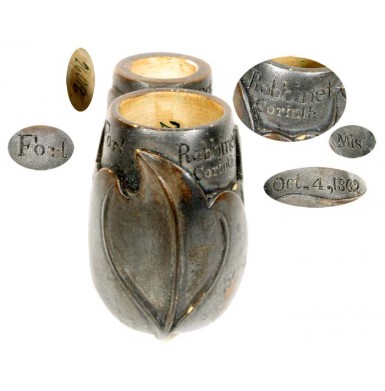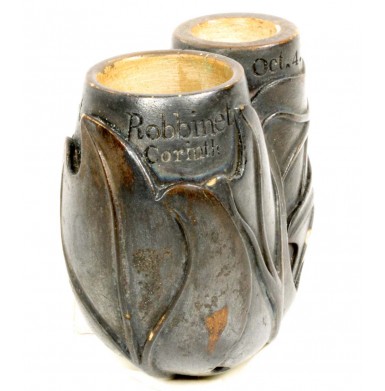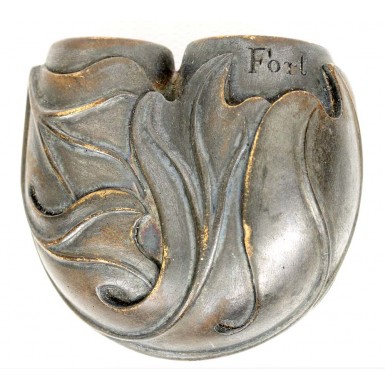Battle of Corinth Carved Pipe from the Flayderman Collection
- Product Code: ALKH-1336-SOLD
- Availability: Out Of Stock
-
$1.00
It has long been said that “war is long periods of boredom punctuated by moments of sheer terror,“ and reading nearly any Civil War era diary or first had account of the period makes it shockingly clear that one of the major concerns by soldier on both sides was how to occupy their time. One of the favorite pass times, for those who had access to tobacco, was to smoke a pipe. Period images make it clear that a large or decorative pipe was often a possession the owner was quite proud of, and liked to display. Similarly, many soldiers occupied their time by whittling or carving, creating those solider-made pieces of keep sake folk art that are in many ways little windows into the lives of these common men, called upon to do uncommon duty. Sometimes the two pass times came together in the creation of customized folk art pipes that were clearly prized possessions of the Civil War era soldier. Some pipes were created from scratch in the field, created from nothing more than a piece of root or wood and coaxed into existence through the careful application of a jack knife and the carver’s skill. Sometimes the raw material was more exotic than common wood, and a pipe was created from soap stone or some other substance that could be manipulated with the careful application of a knife blade. Still other examples started life as commercial pipes, which were subsequently modified and customized, creating a form of trench art during the period where modern trench warfare was only in its infancy. Many times, these pieces of military folk art continued to give comfort and solace long after the war, as they continued to be smoked and cherished by the owners, eventually being handed down through the generations of a family, or sometimes becoming part of a collector’s treasured accumulation of the personal items of a Civil War solider. The late Norm Flayderman saw the great potential to examine this very personal part of the Civil War soldier’s life, and over the decades assembled a fantastic collection of carved and decorated Civil War pipes, with an eye towards producing one a book on the subject, much like he did with his beautifully produced book The Bowie Knife, Unsheathing an American Legend. To this end, he not only accumulated some of the most historically important, aesthetically pleasing and deeply personalized examples of Civil War soldier’s pipes, but also many period images of soldiers in the field with their pipes. Sadly, due to his recent passing (May 23, 2013), Norm’s book project will never be completed, and his collection of fine Civil War pipes has been dispersed. However, the item offered here provides an opportunity to acquire one of the wonderful pipes from his collection, an item that he clearly felt was worthy not only of collecting but publishing as well.
This particular pipe is rather unusual for a Civil War pipe as it is not made from the most commonly encountered material wood, or the secondarily encountered material, soap stone. The pipe may be made from a less commonly encountered type of “soap stone” known as Steatite, which is known as “black pipestone”, which is typically grayish in appearance but with oiling, rubbing and heat takes on a nice black color. The consistency of the stone allows it to be carved with some ease, as it is not likely to crack or flake. The pipe has an overall width of approximately 2.5”, with a bowl height of about 2.25” and a mouth diameter of about 1.25”, which is narrower than its base. The interior diameter of the bowl is .86" and the interior diameter of the stem hole is .58". It is not completely clear if the pipe is carved or cast, although the quality of the pipe suggests it may have been professionally produced and other evidence suggest that it was more likely the former rather than the latter. The striations in the pipe bowl and stem hole suggest that they were bored out, which makes it more likely that the pile was produced from a block of Steatite (or similar material) and was not cast like a clay pipe. No mold marks or seams are visible on the exterior of the pipe. The pipe has a dark grayish-black color on its exterior. The relief carved (or cast) design is a series of deeply veined leaves, with inscriptions on the upper edges of the bowl and stem hole. The carving around the bowl read as follows: Fort, followed by Robbinet over Corinth, with Miss to the rear of the bowl. The date Oct. 4, 1862 is carved on the left side of the stem hole. It is not clear if the name “Robbinet” is misspelled due to a lack of spelling ability, or simply because the carver was “hooked on phonics”, adding a second “b” that was not in the name and eliminating the second “t” that should be at the end of the name. Interestingly, the more common, modern reference to this “fort” is Battery Robinette, suggesting the pipe marking is certainly of the period.
Fort Robinett (Battery Robinett) was established in the summer of 1862 as part of the inner line of Federal defensive works around the town of Corinth, MS. The outer line of defenses to the west of the town consisted of six batteries, designated A through F, which ran in a semi-circular line around the town from the south-east to the north-west. A second line of inner defensives was subsequently established, which were anchored on Fort Robinett at its center, west of the town and about 200 yards north of the crucial Memphis & Charleston Railroad line. The other primary fortifications in the line were Battery Phillips to the south along the Smith-Bridge Road and Battery Powell to the north east. Battery Williams, an additional redan, was located about half way between and slightly east of Batteries Powell and Robinette, in position to support both redans. Fort Robinett was a triangular earthen redan with walls 6” to 8” high, positioned on a minor rise, with a deep trench in front at the approaches. The fort mounted three 20-pound Parrot rifles, one firing from each of the three walls. The position was named for 2nd Lieutenant Henry Robinett, who commanded the position. Henry Clay Robinett was a native of Virginia who attended the Delaware Military Academy (now the Pennsylvania Military College) and was commissioned an 2nd Lieutenant in the US 1st Infantry (Regular Army) on August 5, 1861. He would be brevetted to the rank of captain for his heroic defense of Fort Robinett on October 4, 1862 and would eventually reach the rank of brevet major in the regular army. Sadly, Robinett apparently suffered from some sort of mental defect and his behavior became more and more erratic as the time passed (possibly some form of PTSD”), resulting in his suicide in 1868.
On October 3, 1862, Confederate forces under the overall command of General Earl Van Dorn began their two-day attack on the town of Corinth, in order to recover this important cross road and rail depot. This attack was a continuation of a Confederate campaign that had resulted in the defeat of Confederate General Sterling Price at the Battle of Iuka, about two weeks earlier, on September 19, 1862. The Union forces under the command of General William Rosecrans had advanced from the town of Corinth, taking up positions in old Confederate rifle pits to the north-west of the town, with additional lines of infantry extending around the town to from the north-west to the south east, where the infantry came close to meeting the southern end of the line of earthen artillery redans. Van Dorn pressed his attack on the Union infantry, starting at about 10 AM and eventually pushing the Federal troops back to the inner line of defensive fortifications that were anchored on Fort Robinett in the center. The short fall day and failing light resulted in an end to combat for the day, with Van Dorn convinced that he was only an hour of daylight away from taking the town. The following morning, October 4, 1862 Van Dorn ordered a series of frontal attacks against the heavily fortified Union positions. Colonel William P. Rogers' divisional commander, General Dabney H. Maury, who later described the 2nd Texas Infantry as "one of the finest regiments I have ever seen," ordered Rogers to lead the vanguard of the assault on Battery Robinett. This attack was repulsed with great loss of Confederate life, and the intrepid Rogers led several more, desperate charges. During these assaults, Rogers remained on horseback, exposing himself to the withering array of artillery and musketry issuing from the earthen fort. After several attempts to scale the walls the Confederate troops finally managed to gain entrance to the fort through the embrasures. Rogers seeing that this breech might be exploited reached the 5” deep trench at the base of the fort, dismounted, and led several hundred Texans and Alabamians down into the trench, up the steep embankment, and into the fort. Suddenly federal reinforcements closed in from both flanks and Rogers shouted, "Men, save yourselves or sell your lives as dearly as possible." Seconds later Rogers was struck and killed by multiple projectiles. In mere moments, the 2nd Texas Infantry had lost more than half its numbers in casualties. The failure of Rogers' gallant charge sounded the defeat of Van Dorn and forced the Confederates to retreat. The costly defeat at Corinth cost the Confederates some 4,200 killed, wounded and missing out of the roughly 22,000 men engaged. Federal losses were slightly lower at about 2,500 with a nearly identical number of men on the field. This was one of the few instances during the war when the forces on the field were almost exactly equal in strength, but the fact that the Union was fighting from defensive positions gave them an immense advantage. The Confederate loss at Corinth set the stage for Grant’s Vicksburg Campaign the following year that would result in the Union taking control of the vital Mississippi River life line that would allow the Federal “anaconda” to start squeezing the life out of the south. The great bravery and gallantry of Colonel Rogers did not go unnoticed by the Federal commanders and by order of General Rosecrans, Rogers burial was given all the honor and ceremony of a general officer.
This carved pipe stands as a memento to the gallant fighting that took place on that bloody day in October of 1862. The pipe remains in very fine condition, with only a few very minor surface nicks, some light wear and minor loss to the dark gray-black finish along the high edges and contact areas. An old collection number (possibly a museum number) is written in ink on the interior of the bowl, that reads 260P6. This would be a wonderful addition to any collection that centers on the Battle of Corinth or the men who fought to at Battery Robinett, and I really hope that this pipe somehow ends up going home to a collection in Corinth, MS.
Provenance: ex-Norm Flayderman collection.
SOLD
Tags: Battle, of, Corinth, Carved, Pipe, from, the, Flayderman, Collection






